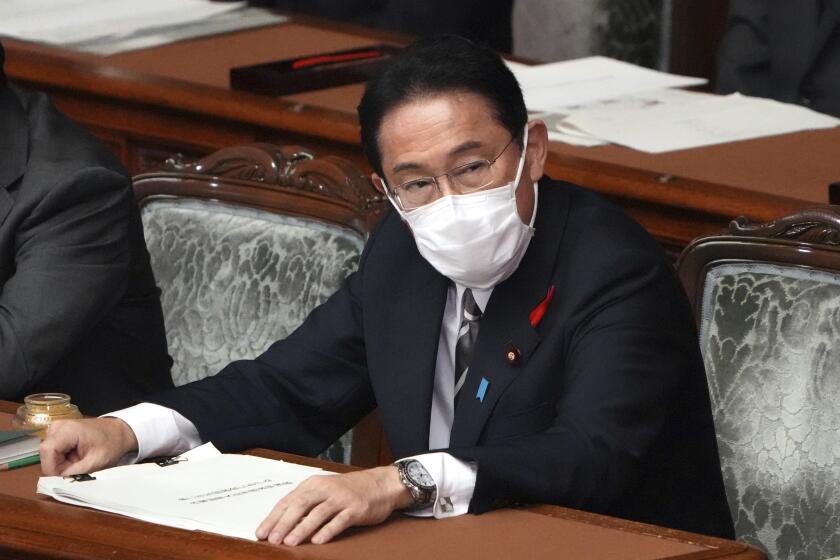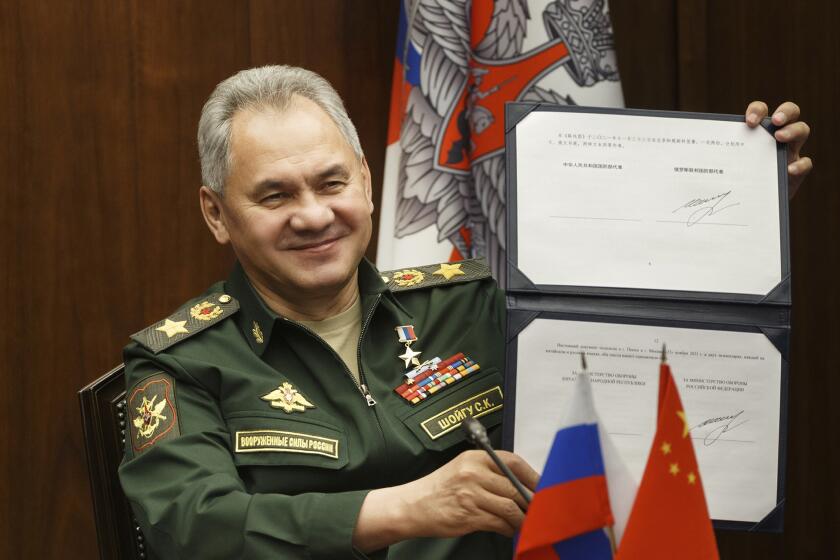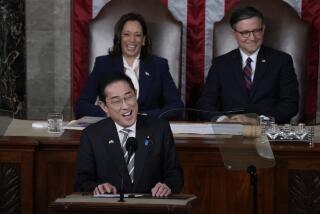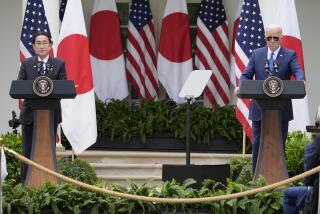Leaders of officially pacifist Japan want to expand military, already one of the world’s strongest
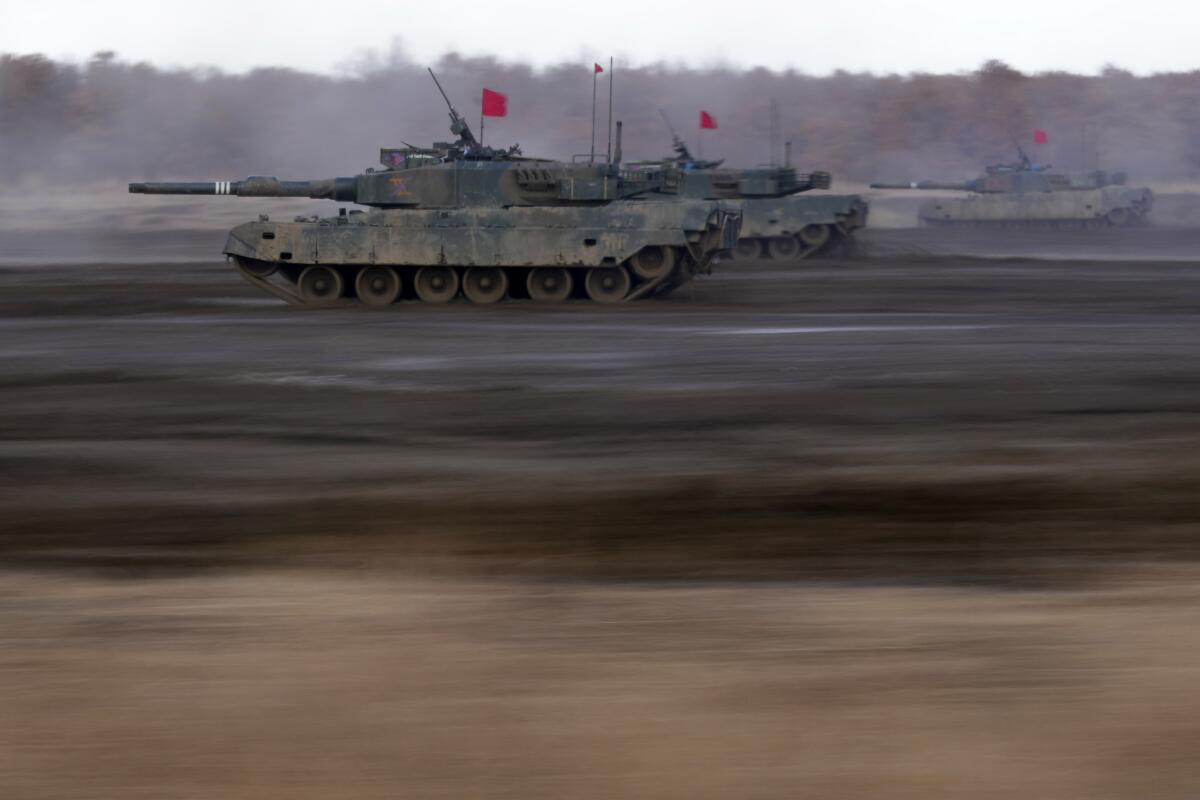
- Share via
ENIWA, Japan — Dozens of tanks and soldiers fired explosives and machine guns in drills Monday on Japan’s northern island of Hokkaido, a main stronghold for a nation that is perhaps the world’s least-known military powerhouse.
Just across the sea from rival Russia, Japan opened its Self Defense Force’s firing exercises to the media in a public display of firepower that coincides with a recent escalation of Chinese and Russian military moves around Japanese territory.
The drills, which foreign journalists rarely have a chance to witness, will continue for nine days and include about 1,300 ground troops. On Monday, as hundreds of soldiers cheered from the sidelines and waved unit flags, lines of tanks shot at targets meant to represent enemy missiles or armored vehicles.
The exercises illuminate a fascinating, easy-to-miss point. Japan, despite an officially pacifist constitution written when memories of its World War II rampage were still fresh, boasts a military that puts all but a few nations to shame.
And, with a host of threats lurking in Northeast Asia, its hawkish leaders are eager for more.
It’s not an easy sell. In a nation still reviled by many of its neighbors for its past military aggression, and where domestic pacifism runs high, any military buildup is controversial.
Pearl Harbor survivors and World War II veterans are gathering in Hawaii to remember those killed in the Dec. 7, 1941, attack by imperial Japan.
Japan has focused on its defensive capabilities and carefully avoids using the word “military” for its troops. But as it looks to defend its territorial and military interests against an assertive China, North Korea and Russia, officials in Tokyo are pushing citizens to put aside widespread unease over a more robust role for the military and support increased defense spending.
As it is, tens of billions of dollars each year have built an arsenal of nearly 1,000 warplanes and dozens of destroyers and submarines. Japan’s forces rival those of Britain and France, and show no sign of slowing down in a pursuit of the best equipment and weapons money can buy.
Not everyone agrees with this buildup. Critics, both at home and in the region, urge Tokyo to learn from its past and pull back from military expansion.
There’s also domestic wariness over nuclear weapons. Japan, the only nation to have atomic bombs dropped on it in war, possesses no nuclear deterrent, unlike other top global militaries, and relies on the so-called U.S. nuclear umbrella.
In his first policy speech, new Prime Minister Fumio Kishida promised to improve Japan’s pandemic response, revive the economy and bolster defense.
Proponents of the new military muscle-flexing say the expansion is well-timed and crucial to Tokyo’s alliance with Washington.
China and Russia have stepped up military cooperation in recent years in an attempt to counter growing U.S.-led regional partnerships.
In October, a fleet of five warships each from China and Russia circled Japan as they traveled through the Pacific to the East China Sea. Last month, their warplanes flew together near Japan’s airspace, causing Japanese fighter jets to scramble. In fiscal year 2020, through March, Japanese fighters scrambled more than 700 times — two-thirds of those times against Chinese warplanes, and the remainder mostly against Russians, the Defense Ministry said.
Russia’s military also recently deployed coastal defense missile systems, the Bastion, near disputed islands off the northern coast of Hokkaido.
Russia and China, in committing to closer military ties, point to increasingly frequent U.S. strategic bomber flights near both countries’ borders.
Japan was disarmed after its World War II defeat. But a month after the Korean War began in 1950, U.S. occupation forces created a 75,000-member lightly armed de facto army called the National Police Reserve. The Self Defense Force, Japan’s current military, was founded in 1954.
Today, Japan is ranked fifth globally in overall military power after the U.S., Russia, China and India, and its defense budget ranked sixth in the 2021 ranking of 140 countries by the Global Firepower rating site.
During arch-conservative former Prime Minister Shinzo Abe’s rule, which lasted more than eight years and ended a year ago, Japan significantly expanded its military role and budget. Abe also watered down the war-renouncing Article 9 of the constitution in 2015, allowing Japan to come to the defense of the U.S. and other partner nations.
Japan has rapidly stepped up its military role in its alliance with Washington, and has made more purchases of costly American weapons and equipment, including fighter jets and missile interceptors.
Start your day right
Sign up for Essential California for the L.A. Times biggest news, features and recommendations in your inbox six days a week.
You may occasionally receive promotional content from the Los Angeles Times.
“Japan faces different risks coming from multiple fronts,” said defense expert Heigo Sato, a professor at the Institute of World Studies at Takushoku University in Tokyo.
Among those risks are North Korea’s increased willingness to test high-powered missiles and other weapons, provocations by armed Chinese fishing boats and coast guard ships, and Russia’s deployment of missiles and naval forces.
One of North Korea’s missiles flew over Hokkaido, landing in the Pacific in 2017. In September, another fell within the 200-nautical mile exclusive economic zone off northwestern Japan.
Under a bilateral security pact, Japan hosts about 50,000 U.S. troops, mostly on the southern island of Okinawa, which, along with Japanese units in Hokkaido, are strategically crucial to the U.S. presence in the Pacific.
North Korea’s new missiles tests renew concerns that the country is building its capacity to deliver strikes on U.S. allies South Korea and Japan.
Japanese Prime Minister Fumio Kishida, who took office in October, said during his first troop review that he would consider “all options,” including possibly pursuing preemptive strike capabilities, to further “increase Japan’s defense power” — a divisive move that opponents say violates the constitution.
Japan has more than 900 warplanes; 48 destroyers, including eight Aegis missile-combating systems; and 20 submarines. That exceeds the individual tallies of Britain, Germany and Italy. Japan is also buying 147 F-35s, including 42 F-35Bs, making it the largest user of American stealth fighters outside the U.S.
Among Japan’s biggest worries is China’s increased naval activity, including an aircraft carrier that has been repeatedly spotted off Japan’s southern coast.
Japan has customarily maintained a defense budget cap at 1% of its GDP, though in recent years the country has faced calls from Washington to spend more.
Japan’s first confirmed infection from the new Omicron coronavirus variant is in a Namibian diplomat who recently arrived from his country.
Kishida says he is open to doubling the cap to the NATO standard of 2%.
As a first step, his Cabinet recently approved $6.8 billion in extra spending for the fiscal year to accelerate missile defense and reconnaissance activity around Japanese territorial seas and airspace, and to bolster mobility and emergency responses to defend its remote East China Sea islands. That would bring 2021 defense spending to $53.2 billion, up 15% from the previous year, and equal to about 1.1% of Japan’s GDP.
In part because of a relative decline in U.S. global influence, Japan has expanded military partnerships and joint exercises beyond its alliance with Washington, including with Australia, Canada, Britain, France and other European countries, as well as in the Assn. of Southeast Asian Nations. Japan also cooperates with NATO.
Despite the government’s argument that more is needed, there are worries domestically over Japan’s rapid expansion of defense capabilities and costs.
“Although the defense policy needs to respond flexibly to changes in the national security environment, a soaring defense budget could cause neighboring countries to misunderstand that Japan is becoming a military power and accelerate an arms race,” the newspaper Tokyo Shimbun said in a recent editorial.
More to Read
Sign up for Essential California
The most important California stories and recommendations in your inbox every morning.
You may occasionally receive promotional content from the Los Angeles Times.

